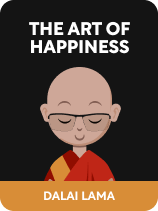

This article is an excerpt from the Shortform book guide to "The Art of Happiness" by Dalai Lama. Shortform has the world's best summaries and analyses of books you should be reading.
Like this article? Sign up for a free trial here .
How do you deal with anger? Is it ever a good idea to express your anger?
According to the Dalai Lama, anger is a destructive emotion that stems from ignorance. If you struggle with anger issues, he counsels, you must first understand where your anger stems from and if it’s justified. Then, use patience and tolerance to neutralize it. You may not be able to completely eradicate it, but you can at least reduce your anger’s potency.
Here’s how to deal with anger, according to His Holiness the Dalai Lama.
1. Educate Yourself to Be Less Angry
According to the Dalai Lama, anger, like other negative emotions, is rooted in a misunderstanding of the world and the nature of emotions. That’s why the first step to taming your anger is to educate yourself on the benefits of tolerance and patience and the destructive nature of anger.
(Shortform note: You can educate yourself on the destructive effects of anger through self-analysis, but you can also turn to science to understand anger’s destructive nature: Suppressing anger can cause you to turn your anger on yourself and lead to chronic passive-aggressive behavior. Patience, on the other hand, has been scientifically proven to lessen the effects of depression.)
2. Develop Your Motivation to Be Less Angry
According to the Dalai Lama, to be less angry, develop your motivation to become patient and tolerant—cures for anger and hatred. The greater your motivation to strengthen these positive emotions, the easier it will be to change your mindset.
(Shortform note: The Dalai Lama recommends fostering patience and tolerance but doesn’t elaborate on how to do this. Build patience by, for instance, finishing one task before moving on to the next. Cultivate tolerance by becoming aware of your conditioned beliefs and how those affect your tolerance for other behaviors or beliefs.)
3. Exert Yourself to Be Less Angry
This step of reducing anger is difficult, claims the Dalai Lama, because it’s hard to combat anger in the moment. Both he and Cutler advise against releasing your anger, as that just compounds it. Instead, the Dalai Lama recommends first relying on the work you do before an anger-provoking situation arises: the steps of educating yourself and developing the motivation to not become angry, as discussed previously.
(Shortform note: It’s been scientifically proven that venting about a negative situation only makes you feel worse. The more you complain in a day, the worse you feel your day has been. Not only that, but venting also spreads negative feelings to those you’re complaining to.)
In a heated moment, the Dalai Lama recommends combating anger by first, as much as possible, educating yourself about it. Understand where it came from and if it’s justified. Then, use patience and tolerance to neutralize it. You may not be able to completely eradicate it, but you can at least reduce your anger’s potency.
(Shortform note: You may notice that even in a moment of anger, the Dalai Lama recommends the steps of 1) educating yourself on your anger, 2) motivating yourself to be less angry, and 3) exerting yourself to combat anger. Therefore, even on a micro-level—the exertion step of lessening your anger—the Dalai Lama leans on this threefold process.)
The Dalai Lama also offers two anger meditations that help you deal with anger when it arises:
Meditate to Be Less Angry
Visualize someone you know becoming extremely angry. Imagine what they look like and how their anger manifests: Perhaps they look scary and raise their voice. Now, recall a time you’ve been this angry. What did you do and how did you look? Decide that you’ll never again become that angry because of the negative effects on your behavior, appearance, and so on.
(Shortform note: What the Dalai Lama describes here is akin to visualization. This is a technique most often used to help you achieve goals, but the Dalai Lama recommends it to help you avoid bad outcomes. Visualization has benefits beyond reinforcing your determination to do better, as the Dalai Lama indicates: It also primes your subconscious to come up with ideas for how to do better. With anger, therefore, visualization might help you consciously decide to become less angry, but subconsciously, might also prompt you to devise ways to be less angry in the future.)
Visualization
Here’s another anger meditation: Visualize someone you dislike and allow your natural aversive response to them to manifest in your body. Note how you feel—perhaps your fists clench, your heart rate rises, and your mind clouds with negative thoughts. Now, decide you’ll never allow yourself to become angry in this way again because of the painful effect it has in your body.
(Shortform note: This anger meditation is similar to the more scientific advice to simply pay closer attention to your body when angry. Rather than reacting automatically to an anger trigger, delay your response by considering how the anger feels. Being mindful in this way gives your brain time to shift from a reactive and aggressive state to a state of threat response, thus avoiding angry outbursts you’ll later regret.)

———End of Preview———
Like what you just read? Read the rest of the world's best book summary and analysis of Dalai Lama's "The Art of Happiness" at Shortform .
Here's what you'll find in our full The Art of Happiness summary :
- The Dalai Lama's Buddhist path toward happiness
- The use of scientific evidence to support the Dalai Lama's beliefs
- Concrete actions you can take to improve your outlook on life, relationships, and resilience






